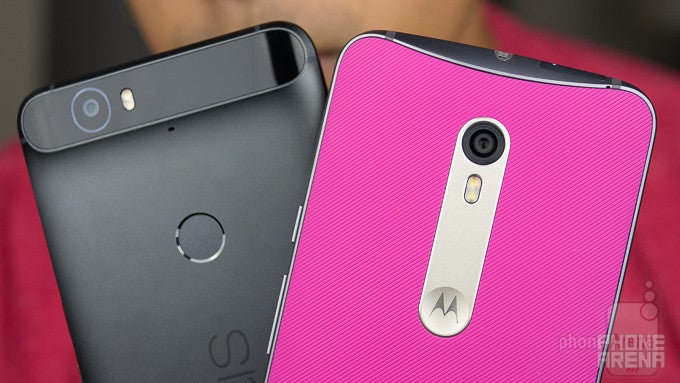Google Nexus 6P vs Motorola Moto X Pure Edition (2015)

Introduction
This year, we’ve seen a huge shift towards delivering ‘low-cost’ premium smartphones – you know, high-end spec’d things under the $500 threshold. Traditionally speaking, phones positioned in the upper end of the spectrum have been priced at around $600 at the very least, but with these two smartphones in this comparison, they’re radically redefining the expectations.
The Google Nexus 6P is undoubtedly impressive taking into account its premium metal design, which is unprecedented given the fact it’s attached with a starting cost of $499.00. Equally on the same pedestal, the Moto X Pure Edition comes at us with a highly customizable design at an even lower, $399.99 cost of ownership. Combining killer specs with price points that undercut the competition, it’ll be intriguing to find out exactly how they stack up against one another.
Design
Yet another testament to what can be achieved on such a strict budget, it’s almost unfathomable that they both have attractive and compelling designs. The Nexus 6P, in particular, is stunning looking and it’s the more premium one between the two – attributed to its originality, svelte profile, and aluminum construction. Yes, it’s considerably longer, but its sturdy feel in the hand can’t be matched by its rival.
While it’s thicker and slightly heavier, the Moto X Pure Edition offers a bit more flair with its highly customizable design. In fact, no other phone can compete with the diversity and color combinations that the Moto X Pure Edition offers via Moto Maker – the online portal that allows buyers to select various colors, finishes, and accents for the phone. And on top of that, the arch to its casing gives it a slightly more ergonomic feel in the hand.
We’ll certainly applaud the two for their solid efforts, showing that beautiful designs are obtainable even on a budget. If premium and sturdiness are more your forte, go with the Nexus 6P. However, if flair and style are what matters to you more, then the Moto X Pure Edition is the no-brainer selection.
The Google Nexus 6P’s main distinction, aside from its premium design, is the handy fingerprint sensor slapped on its back. Having it on board enables it for Android Pay, in addition to the added level of security it offers. As for the Moto X Pure Edition, it lacks the modern convenience of a fingerprint sensor, but it comes with a microSD slot for expandable storage.
Display
They settle for nothing less than Quad-HD display! That’s certainly an impressive accomplishment considering how they undercut many other phones with their low lost, but it merely indicates that it’s obtainable. Details are no different with the two, since they’re both endowed with 5.7-inch panels, but the Moto X Pure Edition opts to go with IPS-LCD technology – while it’s AMOLED for the Nexus 6P.
On the surface, there shouldn’t be any complaints about the two. As we use them day-to-day, though, we notice some superiority to the Moto X Pure Edition's display. Not only is it significantly brighter at a staggering 715 nits, making it one of the brightest screens around, but it produces colors accurately in the sRGB color gamut chart.
In comparison, the Nexus 6P achieves a maximum luminance of 356 nits, which is far from its rivals’ output – making it tougher to view outdoors. At the same time, too, its color reproduction is skewed by its intense saturation on the default setting. That’s unless you tinker around with the developer settings to enable the sRGB color mode, which then gives the same accuracy as its competitor.
We’re mostly leaning toward the Moto X Pure Edition with this one, mainly because its potent brightness output is unmatched.
Interface and Functionality
Being given the Nexus moniker, it means that the Nexus 6P is constantly going to be on tap to receive the newest updates for Android. At the current moment, it’s running stock Android 6.0 Marshmallow. Having that on board, there are few complaints about the experience because it strikes a favorable balance between visual appeal, performance, and features. The straightforwardness of stock Android gives its broader appeal.
To be fair, the Moto X Pure Edition isn’t very far from technically being vanilla as well, seeing that its Android 5.1.1 Lollipop is very much faithful to stock, but with a few enhancements from Motorola. Those enhancements help to deepen the experience, like how the phone knows you’re driving and can automatically reply to incoming phone calls with a text message. And even though it might not be as speedy as its rival when it comes to receiving new software upgrades, there’s no denying that they’ll still come in a relatively timely manner.
We don't consider the Moto X Pure Edition running the older software a deal-breaker, mainly because it’s still very much stock-like with some added features that complement the experience. On the flip side, though, you can never go wrong with stock Android with the Nexus 6P either.
System Performance
Let’s not beat around the bush, the Nexus 6P achieves the snappier overall performance between the two. We shouldn’t be too surprised by that reality, not only because it’s running stock Android, but also because it’s powered by the more formidable hardware – a quad-core Qualcomm Snapdragon 810 SoC accompanied with 3GB of RAM and the Adreno 430 GPU. While it’s still a fearsome package, the Moto X Pure Edition’s hexa-core Snapdragon 808 chip with 3GB of RAM and the Adreno 418 GPU is consistently just behind its rivals pace in various benchmarks.
Benchmarks aside, we can tell you that the Moto X Pure Edition is super responsive, but the Nexus 6P just exhibits more snappiness, pep, and finesse with its overall operation. The Nexus 6P’s superiority is even notable with graphics processing, where it achieves smoother frame rates than Moto’s offering.
Camera
Some people believe that more is better, so if that’s the case, the Moto X Pure Edition would generate more buzz with its 21-megapixel camera sensor. It’s such a massive tally in comparison to the Nexus 6P’s 12.3-megapixel snapper, which might seem quaint, but as all really know, a camera’s megapixel count is never the sole indicator of its quality. Besides that, they actually share some commonalities – like their f/2.0 aperture lenses, dual-LED flash configurations, and up to 4K UHD video recording.
Honestly, we don’t find one camera interface any more intriguing versus the other. That’s partly because they’re pretty light in what they offer, but to be fair, their straightforwardness eliminates any complications when it comes down to snapping photos. While they both offer few shooting modes apart from the typical things, such as panoramics and HDR, we do like how the Moto X Pure Edition offers instant access to the camera by merely twisting our hand a couple of times while holding onto the phone.
Image Quality
It’s a close race between these two cost-conscious smartphones, but if we’re to pick a winner, it’d have to be the Google Nexus 6P. The Nexus 6P composes images that appear sharper, and more importantly, captures nearly the same level of detail as the Moto X Pure Edition. In addition to that, its slightly warmer color reproduction gives its photos more pop and vibrancy. Well, the Moto X Pure Edition handles the occasion with just as much intensity – and it’s by far one of the best from Motorola’s camp.
When using them under dimly lit conditions, we do like how they both produce bright looking photos that expose details thanks to their longer exposures. Sure, there’s a big drop to fine details in the process, giving photos an overall smudgy tone, but the results are still pretty favorable and forgiving. While there’s some presence of digital noise, the Nexus 6P continues to capture our attention due to its visibly warmer color tones.
Video Quality
Although it’s not a knockout win for the Nexus 6P when it comes to snapping still images, the tides turn in favor of the Moto X Pure Edition when it pertains to recording video. Indeed, there’s no issue in terms of detail capture by the two, especially when using the 4K UHD recording option, but there are simply more favorable qualities out of the Moto X Pure Edition. Specifically, it features software stabilization to keep its footage steady, it’s faster with its focus, and have longer digital zoom. We just don’t like how it has a bit more of that wobbly or jello-y effect when panning quickly. As for the Nexus 6P, it’s more properly exposed, but it’s rather slow with its focus and it’s shakier too.
Multimedia
Going with the stock approach, Google’s Play Music app is what’s on tap when it comes to the default music players with the two phones – so yeah, there’s no advantage given to either device. What’s really great, though, is that they’re armed with dual front-firing speakers. Of course, the presentation is ideal for watching videos because audio is being projected towards us, but the Moto X Pure Edition’s pair are simply more potent.
We’re entertained watching videos on both of them , especially when they have all the qualifications for the occasions. Not only do they have attractive and sharp looking screens, but their front-firing speakers really complement the experience. Frankly, we don’t find either one to be greatly better than the other, so either one will suffice.
Call Quality
Granted that their earpieces are loud enough to discern voices in the noisiest of conditions, the Moto X Pure Edition is nearly perfect with its overall performance. From the clear voices coming out of its earpiece, to the distinctive tones out of its speakerphone, we have no complaints about what it dishes out. Conversely, the Nexus 6P has some opportunities, like how voices sound artificial, which gives its overall package an average-like experience.
Battery
Based on their sizes, you’d think that the Moto X Pure Edition would be the one packing along the beefier battery, due to its thicker size, but it’s actually the slimmer Nexus 6P that’s carrying the larger 3450 mAh battery cell – versus the 3000 mAh one in the Moto X Pure Edition. Strangely, though, their battery performances don’t differ from one another, just because we’re able to generally achieve a good one-day of normal usage.
That experience is plainly reaffirmed running them through our custom battery benchmark test, where they reach nearly the same times – 6 hours and 29 minutes for Motorola’s offering, and 6 hours and 24 minutes with the Nexus 6P. In another close race, it doesn’t take all that long to get either one recharged back to full capacity. Impressively enough, it only takes the Moto X Pure Edition 76 minutes to achieve it – while the Nexus 6P isn’t too far away at 89 minutes.
Conclusion
Gone are the days of when high-end phones required you to spend a fortune on them, just because this year in particular, we’ve seen a huge shift by companies to deliver high-spec’d smartphones at significant discounts. Both the Google Nexus 6P and Moto X Pure Edition prove that this trend is an attractive prospect, as they come at us with some impressive qualities. Out of everything, it’s their sub $500 costs that make them the rogue bandits in the space – showing us that you don’t need to empty your savings just to pick up something high-spec’d.
Picking a winner is always tough, especially when there are so many things to factor in. When it comes to price point, there are certainly plenty of head-turning traits present here that shed light on these two products, but the Moto X Pure Edition’s starting cost of $399.99 is hard to overlook – more so when you’re spending $499 to pick up the Google Nexus 6P. To tell you the truth, you won’t be disappointed by either phones, just because they offer incredible value that’ll make you second guess a decision to pick up a phone above $600.
Going back to the difference in price, the $100 extra you’re paying for the Nexus 6P goes towards its more premium metal construction, stock Android experience, higher-tier processor, and fingerprint sensor. It’s a fantastic phone that certainly impressed us for bringing back the premium quality to the Nexus line, but Motorola’s efforts in the Moto X Pure Edition are tough to overlook. It’s still the only phone in the market that gives buyers that highly customizable touch with its design, and it brings to the table plenty of top-notch qualities that reaffirm its reputation of delivering great value
Google Nexus 6P
Pros
- Stock Android 6 experience
- Original looking design with premium feel
- Built-in fingerprint sensor
- Incredibly snappy performance in daily use
- Camera is surprisingly good
Motorola Moto X Pure Edition (2015)
Pros
- Hard-to-beat starting cost of $400
- Highly customizable design
- One of the brightest screens around
- Near perfect call performance
- Expandable storage via micrsoSD slot
























Things that are NOT allowed: